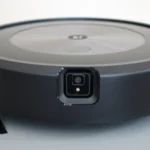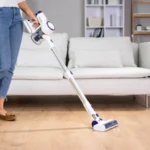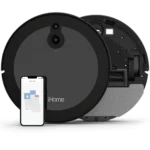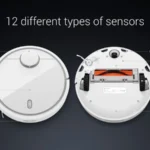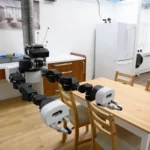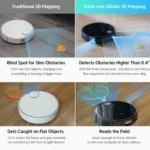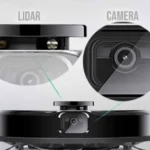Smart vacuum cleaners have revolutionized the way we clean our homes, making life easier for millions of people around the world. However, as the technology continues to advance, there remains an intriguing question of what lies ahead for these innovative devices. One crucial aspect of ensuring that smart vacuum cleaners perform their duties effectively and safely is obstacle detection and avoidance. In this article, we will explore the various obstacle detection and avoidance methods currently available, as well as examine the advancements that have been made in this area. We will also discuss what the future holds for smart vacuum cleaners’ obstacle detection and avoidance systems, including innovative sensor technologies, smarter navigation, and predictive cleaning. Join us as we venture into the exciting world of the future of obstacle detection and avoidance in smart vacuum cleaners.
Importance of Obstacle Detection and Avoidance
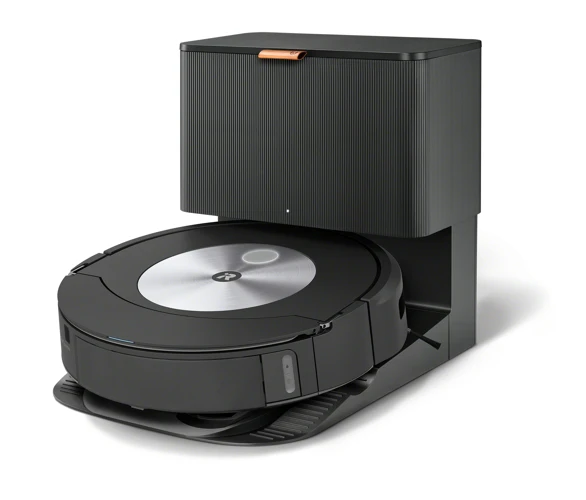
As our homes get smarter, so should our cleaning tools. Smart vacuum cleaners have revolutionized the way we keep our living spaces tidy, but one of the most critical aspects of these devices is obstacle detection and avoidance. Efficient obstacle detection is crucial to prevent potential damage to furniture, personal belongings and the device itself, while avoiding collisions increases safety for the household. Having obstacle detection technology can also help to optimize cleaning by identifying areas that require more attention and avoiding areas that have already been cleaned. In this section, we will explore the importance of obstacle detection and avoidance in smart vacuums and the various methods used to improve their performance. To learn more about smart vacuums and obstacle detection, check out our related article.
Increased Safety
One of the key benefits of obstacle detection and avoidance in smart vacuum cleaners is the increased safety it provides. With the ability to detect and avoid obstacles in real-time, these devices can prevent collisions that can lead to injuries, property damage, or other forms of accidents.
To understand how obstacle detection and avoidance ensure the safety of the device, let’s delve into the current obstacle detection methods used by smart vacuum cleaners.
| Obstacle Detection Method | Benefits |
|---|---|
| Infrared Sensors | Useful in detecting small objects that are low to the ground. |
| Cliff Sensors | Prevents the device from falling to lower levels like stairs or ledges. |
| Camera-Based Sensors | Capable of recognizing objects of different shapes, sizes, and colors. This allows for more accurate obstacle detection and avoidance. |
| Time-of-Flight Sensors | Provide more accurate distance measurements and can detect obstacles that are farther away. |
| Acoustic Sensors | Can detect soundwaves reflected from an object, useful in detecting soft objects like curtains. |
| Magnetic Sensors | Capable of detecting metallic objects like furniture or appliances that are not easily detected by other sensors. |
| Laser Sensors | Provide 360-degree coverage and can detect small and narrow objects like chair legs. |
| Combination Sensors | Useful in detecting objects in various shapes, sizes, and materials. |
As we can see from the table, different obstacle detection methods can provide multiple benefits that promote safety. For instance, cliff sensors can detect if the device is too close to a ledge, helping to prevent accidents.
However, the current methods have limitations. For example, acoustic sensors may not be able to detect objects that are too far away, and time-of-flight sensors may be less accurate in detecting dark or shiny surfaces. New challenges can arise as the environments change. For example, a furniture rearrangement can obstruct the device’s path, causing collisions.
To address these limitations and challenges, many technological advancements have recently been made in obstacle detection and avoidance for smart vacuum cleaners. Some of these advancements like cloud-based mapping and advanced navigation systems allow the devices to better understand their surroundings and avoid obstacles more intelligently.
With these advancements and continued innovations, we can expect the future of obstacle detection and avoidance in smart vacuum cleaners to continue to provide increased safety and prevent accidents.
Optimized Cleaning
Smart vacuum cleaners equipped with obstacle detection and avoidance systems offer an optimized cleaning experience that saves time and energy. These systems allow the vacuum to navigate around obstacles and furniture, ensuring that every corner of the room is spotless.
Improved Cleaning Efficiency: With obstacle detection and avoidance capabilities, smart vacuums can navigate around furniture and other obstacles easily, making cleaning more efficient. This means that the vacuum can clean the entire room without getting stuck in one spot, saving both time and energy.
Prevent Damages and Accidents: Even the most careful homeowner can accidentally damage their furniture or fixtures while vacuuming. However, with obstacle detection and avoidance systems, smart vacuums can work around them without the risk of any damage. This feature also increases safety for pets and family members as the vacuum avoids running into them or injuring them.
Increased Coverage Area: With proper obstacle detection and avoidance systems, smart vacuums can navigate around tight spaces and small furniture, ensuring they are clean. This means that the vacuum can handle more cleaning tasks with ease, resulting in a cleaner home overall.
Customized Cleaning: Smart vacuums with advanced obstacle detection and avoidance systems come with an option to customize cleaning routes based on a map of the house. This feature allows homeowners to specify the areas that need the most cleaning attention, and the vacuum takes care of it without supervision.
Obstacle detection and avoidance systems in smart vacuum cleaners optimize the cleaning process, making it more efficient and customized. It also adds an additional layer of safety for family members and pets, preventing any accidents or damages. Smart vacuums take the drudgery out of cleaning and make it easy for busy people to maintain a clean and comfortable home. For more information on common problems with obstacle detection in smart vacuums visit /common-problems-obstacle-detection-smart-vacuum/ or learn more about smart vacuum obstacle detection features at /smart-vacuum-obstacle-detection-features/.
Current Obstacle Detection and Avoidance Methods
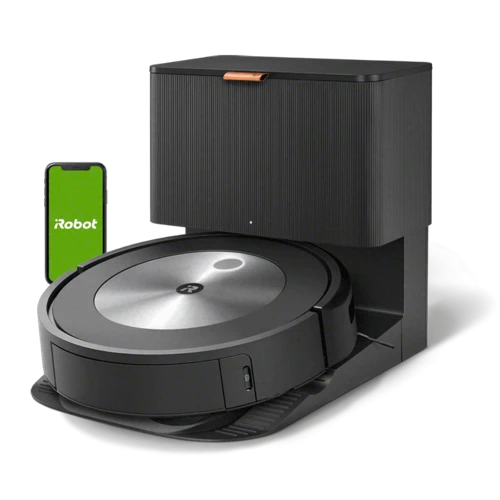
As smart vacuum cleaners become increasingly popular, the importance of obstacle detection and avoidance cannot be ignored. After all, nobody wants their trusty cleaning companion to damage their furniture or, even worse, hurt someone. Currently, there are several obstacle detection and avoidance methods utilized by these machines. In this section, we will explore each of these methods in detail, examining their strengths and limitations.
Infrared Sensors
Infrared sensors are a common method used for obstacle detection and avoidance in smart vacuum cleaners. These sensors emit infrared light and then measure the reflection of that light to detect obstacles in the vacuum’s path.
Advantages
- One major advantage of infrared sensors is their low cost and simplicity.
- Infrared sensors are also highly reliable and can detect most types of obstacles in the vacuum’s path.
- They are also very precise and can detect even small objects.
Disadvantages
- Infrared sensors have limitations depending on the color and texture of the object they are detecting. For example, shiny surfaces can reflect infrared light and create inaccurate readings.
- Infrared sensors are also limited in their range and can only detect obstacles within a certain distance.
- Infrared sensors can also be affected by sunlight or other sources of infrared light in the area.
Despite their limitations, many smart vacuum cleaners still use infrared sensors as a primary method of obstacle detection and avoidance. They are reliable and effective for most types of obstacles, making them a cost-effective solution. However, in order to advance the capabilities of smart vacuum cleaners, new and innovative sensor technologies are being developed and integrated into these devices.
Cliff Sensors
One of the main methods used for obstacle detection and avoidance in smart vacuum cleaners is the use of cliff sensors. These sensors are designed to detect any cliffs or drop-offs, such as stairs, that the vacuum may come across during its cleaning cycle.
Cliff sensors work by emitting beams of infrared light that bounce off surfaces and return to the sensor. If the sensor does not receive the beam back, it alerts the vacuum that it has reached the end of a surface, indicating the presence of a drop-off.
Cliff sensors are vital for safety reasons, ensuring that the vacuum does not accidentally fall down a flight of stairs or any other kind of drop-off. This not only protects the vacuum, but also any objects or people that may be nearby.
While a useful method for obstacle detection and avoidance, cliff sensors do have their limitations. They may not accurately detect drops that are smaller than their set threshold or if the vacuum is moving too fast. Additionally, some users have reported issues with false positives, where the sensors detect a drop-off where there is none.
Despite these limitations, cliff sensors remain a widely used method for obstacle detection and avoidance in smart vacuum cleaners. Manufacturers continue to improve and refine their sensors, ensuring they are more accurate and efficient, giving consumers better performance and safer cleaning experiences.
Camera-Based Sensors
Camera-based sensors are becoming increasingly popular in smart vacuum cleaners due to their ability to provide high-resolution images of the cleaning environment. The technology uses a camera mounted on the vacuum cleaner that captures images of the surrounding area and analyzes them to detect obstacles.
Advantages of Camera-Based Sensors:
- High accuracy in obstacle detection.
- Can identify objects that other sensors may not recognize, such as cords or cables.
- Can be used in low light conditions.
- Provide visual feedback to the user.
The camera-based system works by capturing multiple images of the surrounding environment and analyzing them to detect any obstacles in the way. The vacuum cleaner then uses this information to navigate around the obstacles and continue cleaning.
Limitations of Camera-Based Sensors:
- Require a significant amount of processing power to analyze images.
- May not work well in extremely bright or reflective environments.
- May be obstructed by objects in the environment, resulting in incomplete or inaccurate image capture.
Given the advancements in camera technology, it is no surprise that camera-based sensors have become increasingly popular in smart vacuum cleaners. Not only do they provide high accuracy in obstacle detection, but they also offer a visual representation of the cleaning environment, giving users a better understanding of how the vacuum cleaner is performing. It is expected that in the future, camera-based sensors will continue to improve and become even more accurate, making smart vacuum cleaners even more effective at cleaning our homes.
Time-of-Flight Sensors
Time-of-Flight sensors use a type of technology that measures the time it takes for light to travel to an object and back to the sensor. This method allows for highly accurate distance measurements and is commonly used in 3D imaging and mapping applications. When integrated into smart vacuum cleaners, Time-of-Flight sensors allow for precise object detection and avoidance.
Some advantages of Time-of-Flight sensors in smart vacuum cleaners include real-time obstacle detection, accurate distance measurement, and reliable performance in different lighting conditions. Additionally, because Time-of-Flight sensors don’t require the use of additional infrared reflective surfaces, they tend to have a lower cost of implementation than some other sensor types.
However, there are also some limitations to consider when using Time-of-Flight sensors in smart vacuum cleaners. For example, these sensors are not well-suited for detecting transparent or highly-reflective surfaces. Some Time-of-Flight sensors may struggle to accurately measure distances over very short distances, such as when the smart vacuum cleaner is navigating through cluttered or densely-packed areas.
Despite these limitations, Time-of-Flight sensors are expected to play an important role in the future of smart vacuum cleaner obstacle detection and avoidance. As advancements in sensor technology continue to be made, we can expect to see more robust and reliable Time-of-Flight sensors integrated into smart vacuum cleaners, allowing for even more precise and responsive navigation capabilities.
Acoustic Sensors
Acoustic sensors are among the most advanced obstacle detection and avoidance methods available to smart vacuum cleaners. These sensors work by emitting sound waves and detecting how they bounce back from objects in the vacuum’s path. Acoustic sensors are highly sensitive and can detect even small or hidden obstacles, making them ideal for use in areas with lots of furniture or other obstructions.
How do acoustic sensors work?
Acoustic sensors use sound waves to detect obstacles in the vacuum cleaner’s path. The sensor emits a series of high-frequency sound waves that bounce off objects in the room. The sensor then detects the rebounding sound waves and analyzes them to determine the location and distance of the object. This information is then used to adjust the vacuum’s path and avoid collision.
What are the benefits of acoustic sensors?
One of the biggest benefits of acoustic sensors is their ability to detect small or hidden obstacles that other sensors might miss. This can help smart vacuum cleaners clean more thoroughly, even in areas that are cluttered with furniture or other obstructions. Additionally, acoustic sensors are highly accurate and can detect even the slightest changes in the vacuum’s environment, which makes them ideal for use in areas where precision is important.
Are there any drawbacks to using acoustic sensors?
One of the main drawbacks of acoustic sensors is that they can be affected by ambient noise in the room. If the room is very noisy, it may be difficult for the sensor to distinguish between the sound waves it is emitting and the ambient noise in the room. Additionally, acoustic sensors can be more expensive than other types of sensors, which may drive up the cost of the vacuum cleaner.
How are acoustic sensors being improved?
Researchers are constantly working to improve acoustic sensors and make them even more accurate and effective. One way they are doing this is by using advanced algorithms to analyze the sound waves and identify obstacles in real-time. Additionally, some vacuum cleaners are now equipped with multiple acoustic sensors, which allows them to detect obstacles from multiple angles and improve accuracy.
Acoustic sensors are a promising new technology for smart vacuum cleaners, offering high levels of accuracy and precision in obstacle detection and avoidance. Although they do have some drawbacks, such as susceptibility to ambient noise, ongoing research is aiming to improve their effectiveness and make them an even more valuable tool for keeping homes clean and tidy.
Magnetic Sensors
Magnetic sensors are another type of obstacle detection and avoidance method that is used in smart vacuum cleaners. They work by detecting changes in the magnetic field around the vacuum cleaner, which helps the robot to navigate around obstacles.
Advantages of Magnetic Sensors
One of the main advantages of magnetic sensors is that they are extremely accurate. They can detect even small changes in the magnetic field, which means that they are able to navigate around even the smallest of obstacles. Magnetic sensors are also very reliable, and they are able to work effectively in a variety of different environments.
How Magnetic Sensors Work
Magnetic sensors work by using magnets to create a magnetic field around the vacuum cleaner. The robot is then able to detect changes in the magnetic field as it moves around the room. This information is used to create a map of the room, which the robot can then use to navigate around obstacles.
Limitations of Magnetic Sensors
Despite their accuracy and reliability, magnetic sensors do have some limitations. For example, they are not able to detect non-magnetic objects, such as plastic or glass. Additionally, magnetic sensors can be affected by electromagnetic interference, which can interfere with their accuracy.
Comparison with Other Obstacle Detection and Avoidance Methods
When compared to other obstacle detection and avoidance methods, such as infrared sensors or time-of-flight sensors, magnetic sensors have some unique advantages. They are very effective at detecting small obstacles and can work in a variety of different environments. However, they do have some limitations, such as their inability to detect non-magnetic objects.
| Advantages | How They Work | Limitations |
|---|---|---|
| Accurate and reliable | Use magnets to create a magnetic field | Cannot detect non-magnetic objects |
| Effective at detecting small obstacles | Detect changes in the magnetic field | Affected by electromagnetic interference |
Conclusion
Magnetic sensors can be a very effective method for obstacle detection and avoidance in smart vacuum cleaners. While they do have some limitations, their accuracy and reliability make them an attractive option for manufacturers. As technology continues to advance, it will be interesting to see how magnetic sensors are improved and integrated into future smart vacuum cleaner models.
Laser Sensors
Laser sensors are another commonly used obstacle detection and avoidance method in smart vacuum cleaners. These sensors use a focused laser beam to detect objects in front of the vacuum cleaner. The laser beam emitted by the sensor reflects off objects and is then detected by the sensor. The amount of time it takes for the laser beam to return is used to determine the distance between the object and the vacuum cleaner.
One major advantage of laser sensors is their accuracy. They are capable of detecting objects with high precision, allowing for more effective obstacle avoidance. Another advantage is that laser sensors are not affected by ambient light, making them ideal for use in various lighting conditions.
However, there are also some limitations to laser sensors. For one, they tend to be more expensive compared to other sensors. Additionally, because they rely on a focused laser beam, they may not detect objects that are not within their line of sight or that are too small, such as dust particles or small debris. Laser sensors may also struggle to detect objects that are reflective or transparent, as the beam may pass through these objects without reflecting back to the sensor.
Despite these limitations, laser sensors are still a popular obstacle detection method in smart vacuum cleaners. They are often used in combination with other sensors, such as cameras or infrared sensors, to provide more comprehensive obstacle detection and avoidance capabilities. As technology continues to advance, it is likely that laser sensors will become even more accurate, affordable, and widely used in smart vacuum cleaners and other smart home devices.
Combination Sensors
When it comes to obstacle detection and avoidance in smart vacuum cleaners, the use of combination sensors is becoming increasingly popular. These sensors combine multiple detection technologies to provide a more comprehensive picture of the environment and obstacles in the path of the vacuum.
Some examples of combination sensors include:
- Infrared and Ultrasonic Sensors: By combining these two sensing technologies, smart vacuum cleaners can detect even the smallest of obstacles, such as toys or small pieces of furniture, while also avoiding collisions with walls and larger items.
- Cliff and Time-of-Flight Sensors: Combining these two sensors allows for more accurate mapping of a room and ensures that the vacuum does not accidentally fall down stairs or off of ledges.
- Camera and Machine Learning: Using a combination of camera sensors and machine learning algorithms, smart vacuums can more accurately detect obstacles, even in low light conditions, and can learn to identify and avoid obstacles that they have encountered in the past.
- Magnetic and Laser Sensors: By using these two sensors together, smart vacuums can navigate more accurately around rooms with many metallic or reflective surfaces, such as kitchens or bathrooms.
By combining multiple sensing technologies, smart vacuums can provide more effective and efficient cleaning while also avoiding potential collisions and hazards. The combination of sensors also enables these devices to adapt to different room layouts and obstacles, making them more versatile than vacuums that rely on a single type of sensor. In the future, we can expect to see even more sophisticated combinations of sensing technologies that will further improve the effectiveness of smart vacuum cleaners.
Advancements in Obstacle Detection and Avoidance
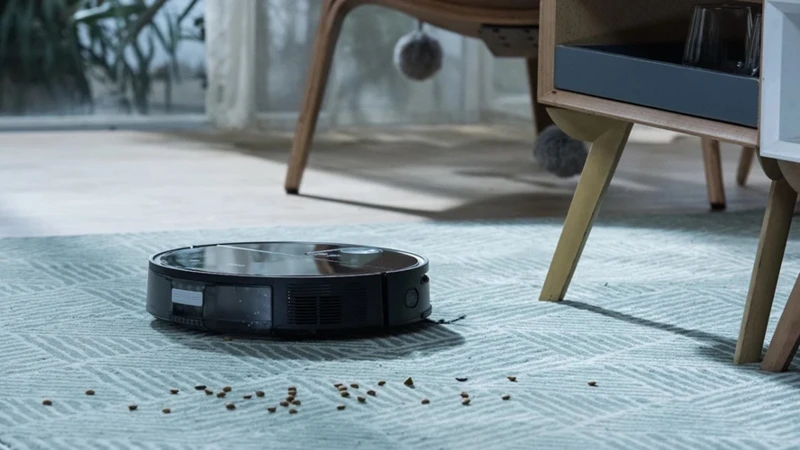
As the demand for smart home devices continues to rise, so does the need for advanced obstacle detection and avoidance in vacuum cleaners. With the help of innovative technologies such as deep learning algorithms, cloud-based mapping, and natural language processing, these devices are becoming more intelligent and efficient than ever before. In this section, we’ll explore some of the advancements in obstacle detection and avoidance that are currently being developed and can revolutionize the way we clean our homes.
Deep Learning Algorithms
One of the most significant advancements in the field of obstacle detection and avoidance in smart vacuum cleaners is the use of deep learning algorithms. These algorithms are designed to mimic the way the human brain works, allowing machines to learn and improve their behavior over time.
Deep learning algorithms are able to analyze vast amounts of data and identify patterns that might be missed by traditional algorithms. This makes them particularly well-suited for tasks like obstacle detection and avoidance, where the ability to detect and respond to subtle changes in the environment is essential.
The use of deep learning algorithms in obstacle detection and avoidance is already making a significant impact. For example, some smart vacuum cleaners now use computer vision to recognize and avoid obstacles, such as furniture and stairs, with a high degree of accuracy.
To illustrate the power of deep learning algorithms, consider the example of a smart vacuum cleaner that is using a camera-based sensor to detect obstacles. Without any prior training, the vacuum cleaner may struggle to differentiate between common objects like tables and chairs, mistaking them for potential obstacles. However, by utilizing deep learning algorithms, the vacuum cleaner can be trained to recognize these objects and avoid them proactively.
Of course, using deep learning algorithms for obstacle detection and avoidance is not without its challenges. The algorithms must be trained on vast amounts of data, and they require significant computational power to operate effectively. However, with advancements in computing technology and machine learning techniques, the potential benefits of deep learning in obstacle detection and avoidance are becoming increasingly clear.
| Pros | Cons |
|---|---|
| Improved accuracy in obstacle detection and avoidance tasks | Requires significant amounts of data for training |
| Provides machines with the ability to learn and improve their behavior over time | Requires significant computational power to operate effectively |
| Well-suited for complex tasks that involve subtle changes in the environment | May be more difficult to implement than traditional algorithms |
Despite these challenges, it is clear that deep learning algorithms have the potential to revolutionize the way smart vacuum cleaners detect and avoid obstacles. As these algorithms become more sophisticated and powerful, we can expect to see further advancements in the field of obstacle detection and avoidance in smart vacuum cleaners.
Cloud-Based Mapping
The integration of cloud-based mapping technology is one of the most exciting advancements in the field of obstacle detection and avoidance in smart vacuum cleaners. With this technology, cleaning devices can interact with cloud servers to obtain data about a particular space, such as a floor map. This allows them to navigate more efficiently and avoid obstacles with greater ease.
Table:
| Advantages | Challenges |
|---|---|
| Accurate real-time mapping of the cleaning space | Requires stable and high-speed internet connection |
| Enhanced navigation and obstacle avoidance | May pose privacy concerns as data is shared on the cloud |
| Can optimize cleaning and create custom cleaning plans | Cost of cloud storage can be high |
The advantages of cloud-based mapping include the ability to obtain accurate real-time floor maps and enhance navigation and obstacle avoidance. By sharing information on the cloud, smart vacuum cleaners can optimize their cleaning, create custom cleaning plans, and work more efficiently. However, such benefits come with certain challenges, such as the need for stable and high-speed internet connection and potential privacy concerns. Additionally, storing data on the cloud can be costly for manufacturers, which may result in higher product prices for consumers.
Despite these challenges, cloud-based mapping remains an exciting advancement in the field of smart vacuum cleaners’ obstacle detection and avoidance technology. It has the potential to further enhance the cleaning capabilities of these devices and increase their adaptability to different environments. With the continued development of cloud technology, smart vacuum cleaners are expected to become even smarter, more efficient, and more user-friendly in the years to come.
Natural Language Processing
Natural Language Processing (NLP) is one of the most fascinating advancements in machine learning that has great implications for the future of smart vacuum cleaners. By leveraging NLP techniques, vacuum cleaners can process and interpret natural language commands, allowing users to control them more effectively.
Here are some ways that NLP can revolutionize the way we interact with smart vacuum cleaners:
- Real-time cleaning instructions: Instead of pressing buttons or using mobile apps to send commands to the vacuum cleaner, users can simply use natural language processing to instruct the device on what to do. They can even give it specific cleaning instructions, such as “vacuum under the sofa” or “clean the kitchen counter.”
- Seamless integration with smart assistants: With NLP, users can give vacuum cleaners instructions using the same voice assistants they use to manage their other smart home devices. For example, a user can simply ask Alexa, “Can you tell my vacuum cleaner to start cleaning the living room?” and expect their vacuum cleaner to fulfill the request; all thanks to NLP.
- Multi-lingual support: With NLP, smart vacuum cleaners can interpret various languages and dialects, making them ideal cleaning companions for households with diverse backgrounds. Users can instruct it in any language of their choosing without the need for additional setup.
- Automated feedback and troubleshooting: With NLP integrated into vacuum cleaners, they will be able to provide feedback to users if anything goes wrong. In case of an error or difficulty, the device can send relevant messages such as “Need new dustbin” or “Brush is blocked” using audio and visual messages, allowing for simple and quick troubleshooting without having to search for the manual.
- Customizable voice settings: NLP allows for the user to personalize their experience with their vacuum cleaner. The voice output or tone can be tailored according to the user’s preference, making the device more suited to their lifestyle and creating a more immersive and engaging experience.
The potential of Natural Language Processing in the future of smart vacuum cleaners is immense. It unlocks a whole new world of possibilities and makes it easier for people to use and control their vacuum cleaner, making household chores less of a hassle. By combining NLP and other advanced technologies, smart vacuum cleaners will evolve to become the perfect cleaning companion that you’ve always wanted.
Advanced Navigation Systems
Advanced Navigation Systems are an essential component for the future of Obstacle Detection and Avoidance in Smart Vacuum Cleaners. These systems will allow for smoother and more efficient cleaning routines while reducing the risk of vacuum cleaners getting stuck or colliding with obstacles.
One of the key advancements in navigation systems is the ability to integrate with cloud-based mapping technologies. This allows for real-time updates of a home’s layout and customization of cleaning routes based on specific preferences. Vacuum cleaners equipped with this technology will be able to adapt to any changes in the environment, such as moving furniture or new obstacles.
Another important feature of advanced navigation systems is the integration with Natural Language Processing technology. With this feature, users can give voice commands to the vacuum cleaner to direct it to specific areas or to avoid certain obstacles. This would be particularly helpful in multi-story homes or homes with complex layouts.
To highlight these advancements, we have created a table showcasing the key features of Advanced Navigation Systems.
| Features | Description |
|---|---|
| Cloud-Based Mapping | Real-time updates of home’s layout and customization of cleaning routes |
| Natural Language Processing | Voice commands for directing the vacuum to specific areas or to avoid certain obstacles |
| Advanced Sensors | Higher accuracy in detecting and avoiding obstacles |
| Machine Learning Algorithms | Adaptive learning to improve cleaning routines over time |
| Intelligent Mapping | Creating a detailed map of the home to optimize cleaning routines |
With the integration of these features, the future of Obstacle Detection and Avoidance in Smart Vacuum Cleaners will allow for more customized and efficient cleaning routines, making them an even more valuable addition to any home. The combination of Cloud-Based Mapping, Natural Language Processing, Advanced Sensors, Machine Learning Algorithms, and Intelligent Mapping will transform the way that vacuum cleaners navigate through homes, ensuring that they can effectively and safely clean all areas with ease.
Robotics and Mobility
The future of smart vacuum cleaners is closely tied to advancements in robotics and mobility. With stronger and more durable robotic components, vacuum cleaners will be able to navigate through any kind of terrain and reach difficult-to-reach areas with ease.
Table 1: Advancements in Robotics and Mobility
| Advancement | Explanation |
|---|---|
| Enhanced motor systems | The motors inside vacuum cleaners are likely to get even more powerful in the future, which will allow them to traverse over a variety of obstacles and terrains easily. |
| Wheels and Treads | Smart vacuum cleaners will be equipped with stronger, more durable wheels or treads, to ensure they have an easier time navigating through rough or uneven terrain. |
| Self-Adjusting Suspension | With self-adjusting suspension, smart vacuum cleaners will adapt to any changes in the terrain and adjust the position accordingly, making it easier to move around and maintain balance. |
| Artificial Intelligence | With advancements in artificial intelligence and machine learning, vacuum cleaners will be able to learn and adapt to changes in their environment and improve their navigation techniques over time. |
| Improved Battery Life | If the battery life is improved, smart vacuum cleaners can operate for longer periods of time without requiring human intervention, which will allow them to navigate through large spaces with ease. |
| Wireless Charging | Adoption of wireless charging of smart vacuum cleaners would allow them to stay functional for even longer without interruption, making navigation through complex terrain much easier. |
As smart vacuum cleaners become more agile, they can navigate through houses with minimal human intervention. Their improved mobility allows them to access any part of the house and clean thoroughly without getting stuck or damaging any furniture. With the help of artificial intelligence, the devices will eventually learn and adapt to specific environments making their cleaning process more efficient.
Improved Battery Life
With the increasing popularity of smart vacuum cleaners, one of the major concerns is their battery life. Fortunately, manufacturers are constantly exploring new technologies to improve the battery life of these devices. Lithium-ion batteries are one such promising technology that is becoming more common in smart vacuum cleaners. These batteries offer several advantages over traditional batteries such as longer battery life, lighter weight, and faster charging.
Another innovative technology being developed for smart vacuum cleaners is wireless charging. This technology eliminates the need for manual charging and provides a convenient and efficient way to recharge the device. Manufacturers are now experimenting with integrating wireless charging systems into smart vacuum cleaners.
To further improve battery life, manufacturers are exploring power management technologies that can optimize the device’s performance based on its battery level. Some of these power management technologies include predictive maintenance, which can identify potential battery issues before they affect the device’s performance, and adaptive charging, which can adjust charging times to ensure optimal battery performance.
Here is a table summarizing the various technologies being explored for improving battery life in smart vacuum cleaners:
| Technology | Advantages |
|---|---|
| Lithium-ion batteries | Longer battery life, lighter weight, faster charging |
| Wireless Charging | Convenient, efficient way to recharge device |
| Power Management | Predictive maintenance, adaptive charging |
As battery life continues to be a priority for smart vacuum cleaner manufacturers, we can expect to see more innovative solutions that improve the device’s performance and user experience. Ultimately, it is up to the consumers to decide which features are most important to them, and which technologies they are willing to pay for.
Integrations with Smart Home Devices
Smart vacuum cleaners have gained popularity due to their convenience and efficiency when it comes to cleaning homes. However, the integration of smart home devices with these cleaning appliances has opened up a whole new world of possibilities. Here are some ways that integrating smart home devices with smart vacuum cleaners can enhance their functionality:
- Remote Control: Integrating a smart vacuum cleaner with a smart home device such as a smartphone, tablet or smart speaker can allow users to control their device from any location. Through an app, the user can start or stop the device and even schedule its cleaning routine.
- Voice Activation: Many smart vacuum cleaners are now integrating with popular voice assistants like Amazon Echo or Google Assistant. This allows users to start or stop their device with just their voice, making their cleaning routine completely hands-free.
- Smart Home Integration: Smart vacuum cleaners can now be integrated with other devices in a smart home, such as smart lights and smart thermostats. This means that when the vacuum cleaner is in use, the smart home can dim the lights or change the thermostat temperature to save energy.
- Virtual Assistants: Integrating a smart vacuum cleaner with a virtual assistant can provide additional support for users. For instance, if the smart vacuum cleaner finds an obstacle it cannot overcome, it can alert the virtual assistant to find a solution.
- Automated Workflows: Integrating a smart vacuum cleaner with workflow automation tools such as IFTTT can provide users with enhanced cleaning routines. The device can be programmed to turn on when a user enters a room or to start vacuuming at a specific time of day.
As technology continues to improve and more smart home devices are developed, the possibilities for integrating smart vacuum cleaners with these devices will only increase. The future of smart home devices is bright, and integrating them with smart vacuum cleaners will continue to bring convenience and efficiency to our daily lives.
The Future of Obstacle Detection and Avoidance in Smart Vacuum Cleaners
As technology continues to advance, so does the ability for smart home devices to enhance our day-to-day lives. One such device that has been making strides in recent years is the smart vacuum cleaner. With the ability to navigate and clean our homes autonomously, these devices have become a time-saver and an essential tool for many homeowners. However, as much as they have simplified our cleaning routines, they still have room for improvement. In particular, advancements in obstacle detection and avoidance technology could revolutionize the way that smart vacuums interact with their environments. So, what does the future hold for obstacle detection and avoidance in these handy devices? Let’s explore some of the possibilities.
Innovative Sensor Technologies
As the demand for efficient and convenient cleaning solutions increases, the development of innovative sensor technologies for smart vacuum cleaners is becoming paramount. These sensors are designed to help vacuum cleaners navigate around obstacles and detect different types of surfaces for optimized cleaning. Here are some of the innovative sensor technologies that are being developed for smart vacuum cleaners:
- 3D Mapping Sensors: These sensors use lasers to create a 3D map of the surrounding environment, allowing the vacuum cleaner to navigate more effectively and avoid obstacles with greater precision. This enables the vacuum cleaner to clean the room more thoroughly, ensuring that no spots are left uncleaned.
- Hyper Spectral Imaging Sensors: Hyper Spectral Imaging Sensors can detect a wider range of pollutants, and they are able to identify different types of surfaces more accurately. This allows the vacuum cleaner to adjust its cleaning speed and intensity to match the surface type, improving its efficiency and reducing the risk of damage to delicate surfaces.
- Cognitive Vision Sensors: Cognitive vision sensors are designed to mimic human vision, allowing the vacuum cleaner to identify and avoid objects with greater accuracy. These sensors use advanced algorithms to analyze the visual data and understand the surrounding environment, improving the efficiency and safety of the cleaning process.
- Environmental Sensors: Environmental sensors can detect changes in temperature, humidity, and air quality, allowing the vacuum cleaner to adjust its cleaning schedule and cleaning intensity based on the surrounding environment. This enables the vacuum cleaner to clean more effectively and ensures that the air in the room is always clean and healthy to breathe.
- Smart Proximity Sensors: Smart proximity sensors can detect the distance between the vacuum cleaner and nearby objects with greater accuracy, allowing the vacuum cleaner to avoid any potential collisions. This enhances the safety of the cleaning process and reduces the risk of damage to the surrounding furniture and objects.
The development of innovative sensor technologies is a crucial step towards creating more efficient and effective smart vacuum cleaners. These sensors help to optimize the cleaning process while ensuring safety and precision. As technology continues to evolve, we can expect to see even more innovative sensor technologies being developed for smart vacuum cleaners in the future.
Smarter Navigation
One of the most exciting advancements in obstacle detection and avoidance for smart vacuum cleaners is the implementation of smarter navigation systems. These systems utilize a combination of sensors and technologies to create a more efficient and effective cleaning experience.
One key technology that is being integrated into vacuum cleaners is LiDAR (Light Detection and Ranging). LiDAR uses lasers to map a room in 3D, creating a highly accurate and detailed visual representation of the environment. This allows the vacuum to navigate around obstacles with ease and avoid potential collisions.
Another navigation technology that is gaining popularity is simultaneous localization and mapping (SLAM). This technology uses sensors such as cameras and lasers to create a map of the environment in real-time. As the vacuum cleaner moves around the room, it uses this map to determine its location and plan its path. This results in a more efficient and methodical cleaning process.
In addition to these sensing technologies, smarter navigation systems also incorporate advanced algorithms and processing power. These algorithms use real-time data from the vacuum’s sensors to make decisions and adjust the cleaning path as needed. This allows the vacuum to avoid obstacles in real-time, even as new obstacles are introduced during the cleaning process.
Smarter navigation systems are a game-changer for smart vacuum cleaners. They allow for more efficient and effective cleaning, while minimizing the risk of collisions and other accidents. By using a combination of sensing technologies and advanced algorithms, these systems are poised to revolutionize the way we think about household cleaning in the years to come.
Predictive Cleaning
Smart vacuum cleaners have come a long way since the introduction of the first robotic vacuum cleaners. They have become more intelligent, efficient, and user-friendly. One of the most anticipated features of future smart vacuums is predictive cleaning. This advanced technology will allow the device to predict where the dirt and dust are most likely to be concentrated, and focus cleaning efforts accordingly.
To achieve predictive cleaning, vacuum cleaners will rely on various sensors and algorithms to map out the cleaning environment, create a cleaning plan, and identify areas that require special attention. With this technology, smart vacuums will be able to clean more efficiently, saving time and energy.
Predictive cleaning makes cleaning a breeze, as the vacuum will be able to anticipate where the dirt will accumulates, and target those areas for cleaning first. For instance, if there are constantly crumbs on the kitchen floor, the vacuum will prioritize that area, rather than cleaning other areas of the house first. This feature will greatly improve the efficiency and effectiveness of the smart vacuum cleaner, ensuring that every inch of the house is cleaned thoroughly.
To achieve this incredible technologic upgrade, smart vacuums will use deep learning algorithms, combined with various sensors such as camera-based sensors and time-of-flight sensors. These sensors will allow the vacuum to map the environment, identify different floor surfaces and, perhaps most importantly, recognize obstacles that need to be avoided. The technology, in turn. will learn based on previous cleaning experiences and adapt to the user’s specific preferences, ensuring that it becomes better with every use.
Imagine never having to worry about picking up crumbs before vacuuming or spending hours looking for missed spots on the floor. Predictive cleaning will change the way we clean our homes and will make life a lot easier for users. The future of obstacle detection and avoidance is incredibly exciting, and predictive cleaning is just one of the many improvements that will revolutionize the smart vacuum industry.
Increased Customization
One of the most exciting advancements in the future of obstacle detection and avoidance in smart vacuum cleaners is the ability for increased customization. This means that users will have more control over the specific settings and tasks that their smart vacuum cleaner performs.
One way this can be achieved is through the use of a customization table that allows users to select which areas of their home they want the vacuum to focus on. This table can also include options for adjusting the speed of the vacuum, the intensity of the cleaning, and the duration of the cleaning cycle.
In addition to customizing specific settings, users will also be able to create a customized cleaning schedule for their smart vacuum cleaner. This can be done through a user-friendly interface that allows users to select which days of the week and what time of day they want their vacuum to run.
To further enhance the user experience, smart vacuum cleaners will also have the ability to remember user preferences and adjust their settings accordingly. For example, if the user always runs the vacuum on a low speed in a certain area, the vacuum will remember this preference and automatically adjust its speed in that area in the future.
Finally, smart vacuum cleaners with increased customization will also have the ability to integrate with other smart home devices. This means that users can set up automated cleaning cycles based on other activities in their home, such as when they leave for work or when they go to bed at night.
The increased customization capabilities of smart vacuum cleaners will provide users with a more personalized and efficient cleaning experience. By allowing users to have more control over their vacuum’s settings and schedule, these devices will be better equipped to meet the specific needs of each individual household.
Voice-Activated Controls
In the future, smart vacuum cleaners will be controlled through voice-activated commands. This advancement in technology will greatly enhance the user’s experience by allowing them to control their device hands-free. With voice-activated controls, users will be able to give their vacuum cleaner direct commands such as start, stop, pause, and resume cleaning. This feature will allow users to customize their cleaning patterns and schedules by simply speaking to their smart device.
Furthermore, voice-activated controls will also enable users to receive real-time notifications about the cleaning status and any issues that may arise during the process. The user could, for instance, ask the device about the percentage of the cleaning process completed or if the vacuum cleaner is facing any obstacles during the cleaning process.
Voice commands will enable users to react to various situations immediately. For example, if the device is stuck on an obstacle, the user can order it to cease its operation, preventing any further damages. Users could also instruct their smart vacuum cleaners to redirect to a different room or specific areas of their home that require extra cleaning. This capability will be especially helpful for individuals who suffer from mobility challenges, elderly people, or individuals with disabilities, who may find it challenging to operate a traditional vacuum cleaner through knobs or buttons.
The integration of voice-activated controls with smart home devices will take this feature to the next level. Communicating with other smart devices within the home, the vacuum cleaner can be turned on or off, or its schedule can be updated through voice commands. This integration will result in fully automated and seamless experience for homeowners.
The implementation of voice-activated controls in smart vacuum cleaners is an exciting development that will improve users’ ease of use and optimize cleaning efficacy. As technology continues to evolve, we can expect more advances to be made in the field of automated vacuum cleaning, making our homes cleaner and our lives easier.
Improved Interaction with Obstacles
Smart vacuum cleaners are becoming more sophisticated and advanced as technology advances. One of the key areas where these devices can improve is in their ability to interact with obstacles. Current obstacle detection and avoidance methods rely on sensors to detect the presence of objects in the cleaner’s path. However, they may not be able to effectively interact with these obstacles, leading to collisions and damage.
The following are some improvements that can be made to the interaction between smart vacuum cleaners and obstacles:
- Improved sensitivity: Vacuum cleaners may need to become more sensitive to the objects in their paths. Using advanced sensors, the cleaners can detect even the smallest objects and navigate around them with ease.
- Adaptive response: Smart vacuum cleaners must be able to interact with obstacles in a variety of ways. For example, if the device encounters a large object, it should be programmed to move around it or avoid collision if possible.
- Intelligent behavior: Smarter interaction with obstacles means that vacuum cleaners should be able to anticipate the movements of static obstacles and adjust their trajectory accordingly. This will help avoid collisions and ensure that cleaning is more efficient.
- Improved programming: Smart vacuum cleaners should be programmed to learn from their mistakes. They should be able to remember previous obstacles encountered and the best ways to deal with them. This would make cleaning more efficient and reduce the risk of damage to the cleaner.
- Efficient navigation: A smart vacuum cleaner should be able to detect obstacles and plan a route around them before they are encountered. This would make cleaning much more efficient, reducing the time taken to navigate around objects that have not been detected earlier.
- Better collision detection: Improved interaction with obstacles also means better collision detection. Smart vacuum cleaners should be able to detect collisions early and take steps to minimize the damage. This would reduce maintenance costs and prolong the life of the device.
Improved interaction with obstacles can significantly enhance the efficiency, safety, and durability of smart vacuum cleaners. Future advancements in sensor technology and machine learning will allow these devices to interact with obstacles more intelligently and efficiently, making cleaning as seamless as possible.
Self-Cleaning Capabilities
Smart vacuum cleaners have come a long way from their simplistic predecessors, and in the near future, they will likely offer even more advanced features such as self-cleaning capabilities. This would mean that they would become more autonomous and require less human intervention.
Below are some potential self-cleaning capabilities that we may see in future smart vacuum cleaners:
- Automatic Debris Disposal: Instead of manually emptying the dustbin, the vacuum cleaner could have the ability to empty it on its own. The device could use a built-in suction system to deposit debris into a separate container or even directly into a trash can.
- Self-Diagnostic Capabilities: The smart vacuum cleaner could analyze its own performance and detect any potential malfunctions or performance issues. This could include detecting clogs, low suction power, and any other potential issues that might affect the cleaning performance.
- Self-Cleaning Brushes: In order to maintain peak performance, vacuum cleaner brushes should remain clean and untangled. Smart vacuum cleaners could have specialized brushes that de-tangle and clean themselves periodically to maximize cleaning performance.
- Automated Maintenance: Smart vacuum cleaners could run maintenance routines on themselves, identifying worn or damaged parts and automatically ordering replacements. This would help to prevent performance issues and enable the vacuum cleaner to operate at peak efficiency.
Self-cleaning capabilities in smart vacuum cleaners would be a major advancement, freeing up time and energy for users and providing a cleaner, more efficient environment.
Conclusion
In conclusion, the future of obstacle detection and avoidance in smart vacuum cleaners appears to be promising. The advancements in sensor technologies, navigation systems, and robotics are driving the industry to new heights. As a result, consumers can expect safer and more optimized cleaning experiences in their homes.
It is clear that obstacle detection and avoidance is of utmost importance in these cleaning devices. With the increased safety features and optimized cleaning capabilities, it is no wonder why consumers continue to invest in these products. The use of infrared sensors, cliff sensors, cameras, time-of-flight sensors, acoustic sensors, magnetic sensors, and laser sensors have already paved the way for more sophisticated and efficient obstacle detection and avoidance processes.
However, advancements in deep learning algorithms, cloud-based mapping, natural language processing, and integration with smart home devices are taking obstacle detection and avoidance to the next level. With smarter navigation and predictive cleaning, consumers can expect a personalized and customized cleaning experience that caters to their individual cleaning needs.
The future of obstacle detection and avoidance in smart vacuum cleaners is marked by exciting and innovative development projects. Self-cleaning capabilities, voice-activated controls, and improved interaction and detection of obstacles are all in the pipeline. With increased battery life and robotics, the cleaning experience will become effortless and more convenient than ever before.
Overall, the future of obstacle detection and avoidance in smart vacuum cleaners is a bright one, with exciting developments on the horizon. As these devices become more and more advanced, the cleaning experience for consumers will become increasingly easy, safe, and efficient. There is no doubt that this technology will continue to revolutionize the cleaning industry for years to come.
Frequently Asked Questions
What is obstacle detection and avoidance in smart vacuum cleaners?
Obstacle detection and avoidance is the capability of smart vacuum cleaners to sense and navigate around obstacles that hinder their cleaning abilities.
What are the benefits of obstacle detection and avoidance in smart vacuum cleaners?
The benefits of obstacle detection and avoidance include increased safety, optimized cleaning, and better efficiency in navigating through rooms.
What are some current obstacle detection and avoidance methods used in smart vacuum cleaners?
Some current obstacle detection and avoidance methods include infrared sensors, cliff sensors, camera-based sensors, time-of-flight sensors, acoustic sensors, magnetic sensors, laser sensors, and combination sensors.
How does cloud-based mapping work in smart vacuum cleaners?
Cloud-based mapping allows smart vacuum cleaners to create a map of the home they are cleaning and use that data to navigate around obstacles more efficiently.
What is natural language processing in smart vacuum cleaners?
Natural language processing allows smart vacuum cleaners to respond to voice commands and interact with users in a more human-like way.
What are the benefits of advanced navigation systems in smart vacuum cleaners?
The benefits of advanced navigation systems include better efficiency and reduced cleaning times through more accurate mapping and navigation.
What improvements in obstacle detection and avoidance can we expect in the future?
We can expect to see innovations in sensor technologies, smarter navigation, predictive cleaning, increased customization, voice-activated controls, improved interaction with obstacles, and self-cleaning capabilities.
How can obstacle detection and avoidance help reduce the likelihood of accidents with smart vacuum cleaners?
Obstacle detection and avoidance helps prevent smart vacuum cleaners from colliding with obstacles or falling down stairs, reducing the likelihood of accidents or damage to valuable items.
What role does deep learning play in obstacle detection and avoidance?
Deep learning allows smart vacuum cleaners to learn from their environment and improve their obstacle detection and avoidance capabilities over time.
What benefits do integrations with smart home devices offer for obstacle detection and avoidance in smart vacuum cleaners?
Integrations with smart home devices allow smart vacuum cleaners to communicate with other devices and access additional data to optimize their cleaning and obstacle detection and avoidance capabilities.


